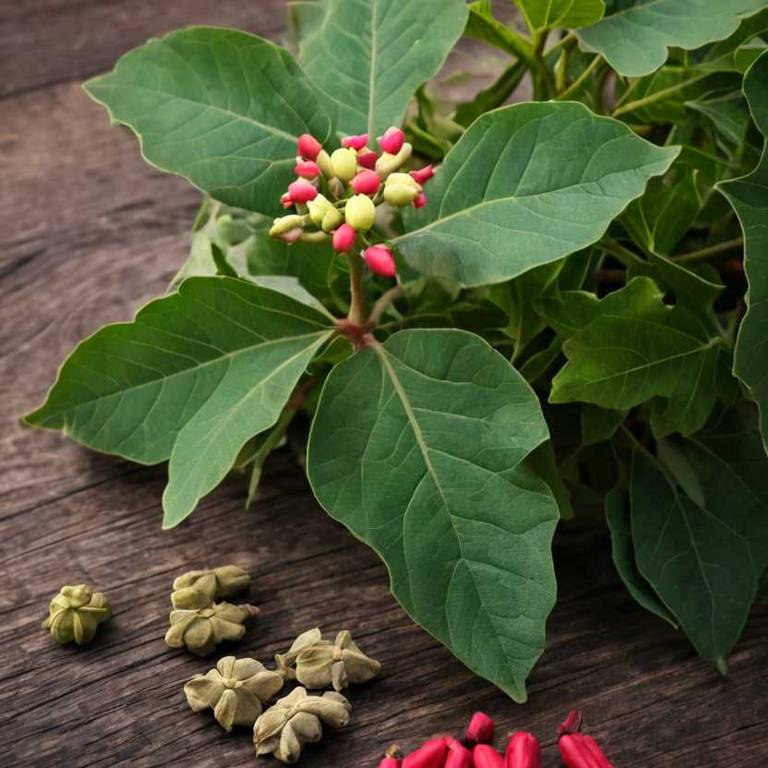By Leen Randell
Updated: Jul 06, 2024
What to know about Jatropha curcas (physic nut) before using it medicinally

Jatropha curcas, commonly known as physic nut, is a herb that has been used for centuries to treat a range of health conditions, from fever and rheumatism to skin conditions and digestive problems.
As a low-maintenance and versatile herb, Jatropha curcas is also prized by gardeners and landscapers for its ornamental value and potential for use in soil remediation. From a botanical standpoint, Jatropha curcas is a dicotyledonous plant in the Euphorbiaceae family, with distinctive white and red flowers and a toxic sap.
References to Jatropha curcas can be found in ancient Ayurvedic and Unani texts, as well as in the work of European colonizers who used the plant as a treatment for various ailments.
This article explains the medicinal, horticultural, botanical, and historical aspects of Jatropha curcas.
What are the medicinal properties of Jatropha curcas?
Jatropha curcas helps with various health conditions such as skin irritations, insect bites, and minor cuts and wounds. Its extracts have also been used to treat fever, rheumatism, and respiratory issues.
The active constituents of Jatropha curcas include phorbol esters, flavonoids, and alkaloids, which contribute to its medicinal properties. Phorbol esters, in particular, are responsible for its anti-inflammatory and antibacterial effects. Flavonoids and alkaloids add to its antioxidant and antiviral properties.
The parts of Jatropha curcas most used for medicinal purposes are its seeds, leaves, and root bark. The seeds contain the highest concentration of phorbol esters, while the leaves are rich in flavonoids. The root bark is often used to treat fever and respiratory issues.
Improper use of Jatropha curcas can lead to side effects such as skin irritation, allergic reactions, and gastrointestinal issues. Ingestion of large amounts of the plant's seeds or leaves can cause vomiting, diarrhea, and stomach pain.
Precautions when using Jatropha curcas medicinally include using standardized extracts, consulting with a healthcare professional, and following recommended dosages. Pregnant or breastfeeding women, as well as individuals with allergies or sensitivities, should exercise caution when using this plant.
What are the horticulural aspects of Jatropha curcas?
Jatropha curcas grow best in full sun with at least 6 hours of direct sunlight. Optimal temperatures range from 24-30°C (75-86°F), with tolerable temperatures up to 35°C (95°F). Soil pH should be between 5.5-7.0, with well-draining sandy loams or clay loams.
Planting tips for Jatropha curcas involve spacing 3-5 meters apart for optimal growth. Seeds are typically planted 1-2 cm deep, with a 2-3 cm layer of soil on top. Seeds can also be sown in nurseries and transplanted when 6-12 inches tall. Water thoroughly during the first year, reducing watering in subsequent years.
Harvesting tips for Jatropha curcas involve monitoring the plant for seed maturity, typically 6-9 months after sowing. Seeds are ready when the outer shell turns dark brown and the inner kernel is soft. Harvest seeds in the morning to avoid moisture accumulation. Hand-pick mature fruits, allowing seeds to dry further before storage.
Common pests affecting Jatropha curcas include the Jatropha moth (Paraspiopteryx jatrophae), which feeds on leaves and seeds. Diseases affecting the plant include root rot caused by Phymatotrichopsis omnivora and leaf spot caused by Cercospora jatrophae. Regular monitoring and timely treatment are essential to mitigate damage.
What are the botanical aspects of Jatropha curcas?
Jatropha curcas is a deciduous shrub or small tree with a broad, rounded crown and a single trunk. The stem is straight, green, and covered with soft, brown, or grayish hairs, up to 10 mm in diameter. Leaves are ovate, alternate, and simple, 10-30 cm long and 5-10 cm wide.
Jatropha curcas belongs to the family Euphorbiaceae and is classified as follows: Kingdom: Plantae, Clade: Angiosperms, Clade: Eudicots, Clade: Rosids, Order: Malpighiales, Family: Euphorbiaceae, Genus: Jatropha, Species: J. curcas. This classification indicates its relationship with other plants.
Variants of Jatropha curcas include J. curcas var. curcas, J. curcas var. elongata, and J. curcas var. glandulosa. These variants differ mainly in leaf shape, size, and flower characteristics. The variations may also be influenced by geographical conditions and environmental factors.
Jatropha curcas is widely distributed in tropical and subtropical regions, including Africa, Asia, Australia, and the Americas. It grows in dry and wet forests, woodlands, and savannas, up to 1,200 m above sea level. The plant has also been naturalized in some regions.
The life cycle of Jatropha curcas begins with germination, which occurs in 1-3 weeks, depending on environmental conditions. The plant grows rapidly, producing a single stem and multiple branches. It blooms after 3-5 years, producing showy, yellowish-white flowers, followed by seed pods containing 1-3 seeds.
What are the historical aspects of Jatropha curcas?
Jatropha curcas is a plant with a long history of use in traditional medicine. In ancient civilizations, including the Aztecs and Mayans, the plant was used to treat various ailments, including fever, rheumatism, and skin conditions.
Mythological references to Jatropha curcas date back to ancient Greece, where it was associated with the goddess Artemis, protector of women and childbirth. In Hindu mythology, the plant was said to have been used by the goddess Parvati to heal her son, the god Ganesha.
Symbolic meanings of Jatropha curcas vary across cultures, but it is often associated with protection, healing, and fertility. In many African cultures, the plant is used in rituals to ward off evil spirits and to promote fertility.
Historical texts that mention Jatropha curcas include the ancient Greek physician Dioscorides' "De Materia Medica" and the Aztec codex "Florentine Codex". These texts describe the plant's medicinal properties and traditional uses.
Historical artifacts that feature Jatropha curcas include Aztec pottery and Mayan frescoes, which depict the plant being used in traditional medicine. These artifacts demonstrate the importance of the plant in the daily lives of ancient civilizations.